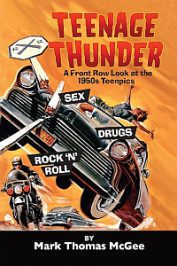The teenager, not present in the immediate post-war years, in the early 1950s suddenly became a financial force and a very visible part of American culture. That also meant clueless parents, disgusted older generations and horrified school teachers, as teenage delinquency and violence ostensibly exploded in the mid-fifties.
 It did not take long before movies studios exploited the topic and attached additional horror and violence to it. This book presents an overview on the various main topics touched in those films of the 1950s.
It did not take long before movies studios exploited the topic and attached additional horror and violence to it. This book presents an overview on the various main topics touched in those films of the 1950s.
Since a number of major factors, both in the background and in plain sight, came together and created an audience for this sort of movie. One component definitely was the birth of rock’n’roll, soon played on American TV and radio. It speedily developed a culture of its own, in terms of style, consumers, behavior, patterns of communication and proved to be a seller. No surprise it soon was marketed by producers of fashion, concert agents, advertisement agencies, and naturally the movie industry, leading to a strong output of films on teenagers. Where they mostly were portrayed as petty criminals out of control. So, quite a few teenpics in this selection of roughly 150 films on 200 pages present a band, bandstand footage or several rock’n’roll hits. Thereby reinforcing the seemingly “dangerous nature” of this kind of music and how easily teenage aggression could be driven by it.
Furthermore, in 1954 movie ticket sales were declining (half of what they were in 1947) as most people now preferred to watch TV at home. Until then, the mainstream entertainment film of the big studios offered nothing but standard topics, usually taking place around the daily routines of grown-ups or older people in their mostly secure environments.
According to author McGee, who has published several books on 1950s films, teenagers “… wanted to see movies that they could relate to, movies with teenage girls ‘in trouble,’ motorcycles and hot-rods, punks with switchblade knives, and monsters from outer space.”
While the major studios largely ignored the particular hunger of that group (although movies such as Rebel Without a Cause (1955) or Blackboard Jungle (1955) are important exceptions), mostly the small and independent studios, known for the B-movie type, saw their chance and put out one teenpic drama after the other. Shot mainly in cheap black and white and advertised aggressively with catchy adjectives, the films were the equivalent to the countless numbers of teenage pulp novels of similar bad quality that introduced known (and commercial successful) stereotype settings and characters. (A number of Elvis films – some mentioned here – catch exactly that environment).
“Teenager Thunder takes a closer look at these movies that were made for us [teenagers of the 1950s], movies that were frowned upon, ridiculed and held in contempt. The movies that your parents didn’t want you to see. For those of us who weren’t yet teenagers at the time, most of the movies dealing with juvenile delinquency were difficult to see.”
The volume – named after a 1957 Howco picture of that kind – is prefaced by a very good 35 pages introduction, here naming the social backgrounds, reappearing stars, plots, directors of such productions, and points to the new wave of teenpics that had almost nothing in common with the standard portraits of the youth or young adults of the 1940s movies anymore. Hence, the book contains nearly exclusively American teenage films that feature motorcycle hoodlums, prostitution, drug use and pushing, organized crime, jealous and furious male lovers, extreme violence, the use of knives and guns, juvenile psychopaths, gang rituals, drag races and hit and run murderers. Furthermore, a number of horror and science fiction titles found their way into the books, as teenagers there are the main characters. Needless to say that usually once a picture introduced a topic, it was quickly covered and copied in a number of other movies that followed.
With explicit titles, the studios wanted to make sure that audiences would not fail to understand what was waiting for them: The Bad Seed,The Beat Generation, A Bucket of Blood, Crime in the Streets, Dangerous Youth, Eighteen and Anxious, Four Boys and A Gun, Girls on the Loose, Hot Rod Girl, I Was A Teenage Werewolf, Reform School Girl or Teen-Age Crime Wave.
For certain actors, such B-movies were also the beginning of a successful career, as it turned out for Marlon Brando, Tony Curtis, Sal Mineo, Mamie Van Doren, James Dean, and John Savage, to name but a few.
This is not an academic text on the nature of the films, but the films mentioned usually come with at least one picture, get covered roughly on one to three pages of text that credits plot, main characters and some background information on actors, director or allusions to a real story.
A very entertaining straightforward coffee-table book loaded with great movies stills.
Review by Dr. A. Ebert © 2020
Mark Thomas McGee. Teenage Thunder – A Front Row Look at the 1950s Teenpics. BearManor Media, 2020, 258 p.
